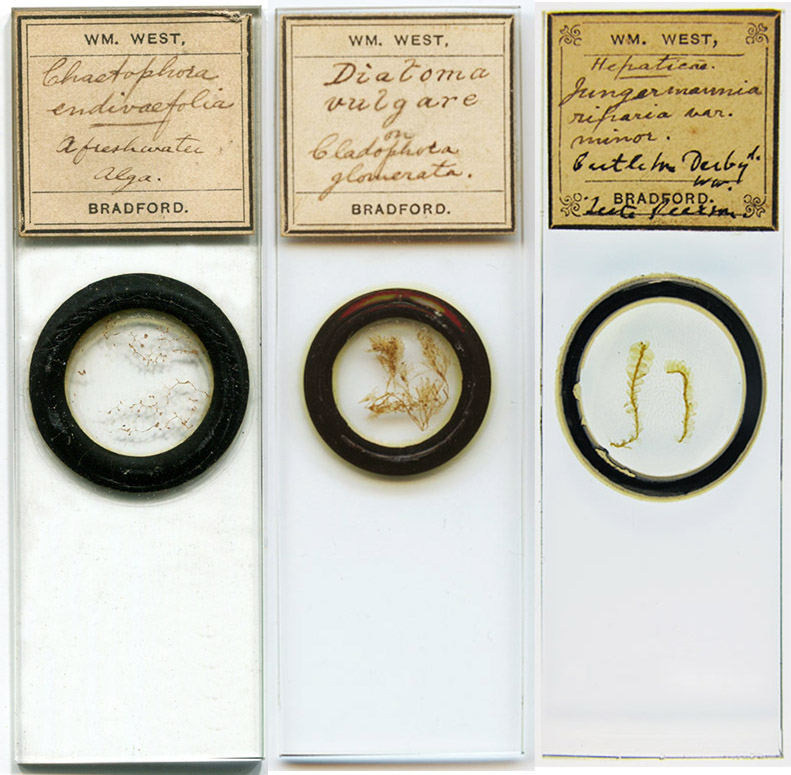
Figure 1. Microscope slides by William West. From the author’s collection, or images provided by the courtesy of Richard Courtiour and Peter Hodds.
William West, 1848 - 1914
by Brian Stevenson
last updated January, 2020
William West is best known to antique microscope enthusiasts as the English distributor for slides made by Jean Claudius Tempère (1847-1926). West was also a very competent slide-maker. It was probably a mutual interest in microscopy, slide-making, and botany that brought Tempère and West together, forming a partnership that lasted for nearly twenty years. In addition, West was a well-known botany expert who published several books and papers on algae, desmids, and other subjects. Initially a chemist/pharmacist, West switched late in life to become a College Lecturer in Botany, Biology, and Bacteriology.

Figure 1.
Microscope slides by William West. From the author’s collection, or images provided by the courtesy of Richard Courtiour and Peter Hodds.
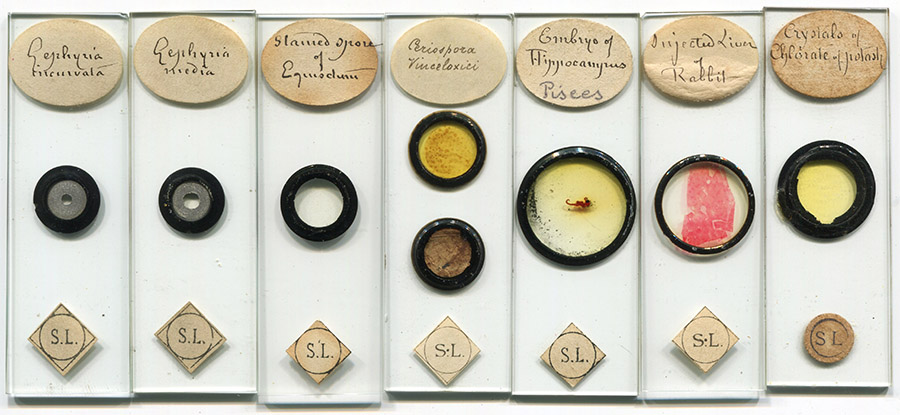
Figure 2.
Microscope slides that were prepared in France by Jean Tempère and sold in England by William West, under the name “S. Louis” (“S.L.”). The partnership lasted from 1883 until at least 1901.

Figure 3.
West and Tempère also sold unmounted specimens throughout the duration of their partnership. Adapted for nonprofit, educational purposes from an internet auction site.
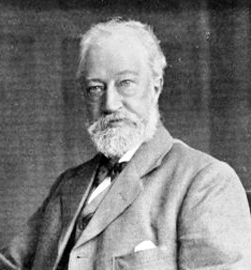
Figure 4.
William West.
William West was born on February 22, 1848, in Leeds, Yorkshire. His father, George, was a “cloth dresser” (i.e., he cut the surfaces of woolen cloth during its manufacture), and his mother, Mary Ann, was a “dressmaker”.
William passed his Chemist and Druggist examinations on November 16, 1870. The 1871 census shows him living with his parents and younger siblings in Leeds, so he probably worked at a nearby pharmacy.
He moved to the nearby town of Bradford in 1872, presumably to start an independent business. The 1873 Proceedings of the British Pharmaceutical Conference listed his address as Horton Lane. He lived at and operated a chemists’ shop at 15 Horton Lane until about 1899.
West married Hannah Wainwright during the summer of 1874, an indication that the business had quickly become financially successful. They had three children, William Jr. (who died at the age of 26 in India), George, and Emily. Son George Stephen West (1876-1919) trained as a scientist, collaborated extensively with his father, and became the Mason Professor of Botany at Birmingham University. Emily became an artist, and remained single through at least 1911, taking care of her then-widowed father.
After his mother died ca. 1875, William’s father, George, and his siblings, George Jr. and Emily, moved into the chemist’s shop. The 1881 census listed both the father and the brother as then being a “chemist’s assistant”.Botany played an important role in pharmacy during West’s time, as plants were important sources of drugs. Pharmacy training often involved training in plant identification and use of the microscope to identify compounds and detect impurities. It is likely that West’s interest in both of those topics stemmed from his training.
The herbariaunited.org group has records of numerous specimens that were collected by William West, or were acquired by him from others. Figure 5 shows plants collected by West in 1878, and a specimen acquired by him from Jean Tempère, originally collected in 1876.
Hardwicke’s Science-Gossip was a popular monthly scientific magazine of the era. Enthusiasts of all types of sciences frequently used the exchange section to enlarge their collections, by offering to swap items. West made his first appearance in the October, 1877 issue, with a request to exchange botanical specimens (Figure 6). Fresh plants were offered in exchange in May, 1878. West wrote a letter to the magazine, published in June, 1878, with tips on maintaining aquaria for microorganisms, indicating that he was actively using his microscope for fun. His advice is practical for modern microscopists: use small glass jars or bottles, filled with water and inoculated with various water plants or algae.
West first offered his own microscope slides in 1879 (Figure 6). Coincidentally, that was also the first time that Jean Tempère offered to exchange his own microscope slides. Previously, Tempère had only offered unprepared botanical specimens. Tempère was then living in Storrington, Sussex, England, working as a French teacher. He had been in England since ca. 1871. Tempère moved back to his home city of Paris around New Years, 1884.
West and Tempère formed a slide-making partnership in early 1883. They adopted the name “S. Louis” for their business, possibly a way to disguise that school-teacher Tempère had taken a second job. Their first known advertisement appeared in Hardwicke’s Science-Gossip in May, 1883 (Figure 7). They also offered fixing cement by S. Louis, probably an adhesive that West created in his chemists’ shop. Other mounting media were later offered, likewise also produced by West. The initial offerings were all unmounted specimens. By November, 1884, they were selling mounted slides of diverse specimens, including diatoms, zoophytes, mollusk palates, and preparations of anatomical pathological, and botanical specimens. Unmounted specimens remained a major part of the business (Figure 3).
The Journal of Microscopy and Natural Science reviewed S. Louis’ preparations in 1884, “Mr. Wm. West, of Bradford, has favoured us with a large selection of his objects, prepared for microscopical mounting, consisting of Diatoms, Spicules, Animal Hairs, Palates, Anatomical Sections Injected and Stained, Vegetable Sections Double Stained, and Miscellaneous, both Botanical and Non-Botanical. These objects are prepared by S. Louis, of Paris. At present we have had time to mount but a few of the above. We think they are all well prepared. The quantity is abundant, and in many cases quite sufficient for a number of slides”. A few months later, the magazine again wrote, “We have mounted a great number of the specimens prepared by Mons. S. Louis (France), and sold by Mr. Wm. West, of Bradford, and find them well prepared, abundantly supplied, and that' they make very excellent Slides. Each series is supplied in a neat wood box, the Diatoms, Algae, and many other objects, being in separate glass tubes. Directions for mounting will be found in each box”.
In 1886, West was appointed Lecturer in Botany at the Bradford Technical College. Advertisements indicate that he retained the Horton Lane chemists’ shop for several additional years (Figures 8 and 9).
West became member of The Linnean Society on March 7, 1887. It was quite an honor to join the premiere botanical organization.
Advertisements from 1899 indicate that West was still at the Horton Lane chemists’. He evidently sold the business soon afterward, as advertisements from 1900 give a new address, 26 Woodville Terrace, Bradford (Figure 10). The 1901 census listed his occupation as “science teacher”, indicating his full-time change to that profession. West continued to distribute Tempère’s slides as S. Louis through at least 1901 (Figure 10).
William's two sons, William West Jr. (1875 – ca. 1900) and George Stephen West (1876 - 1919), both became botany researchers. William Jr. died from cholera while studying in India. William Sr. and George worked together extensively, largely focusing on algae. They jointly published a book on The Alga-Flora of Yorkshire in 1900, based on their 1897 report to the Yorkshire Naturalists’ Union (Figure 11). William served as President of that society in 1899. Another important book, A Monograph of the British Desmidiaceae, was published in 1912 (Figure 12).
William West died on May 15, 1914, from heart failure, possibly associated with the asthma he had suffered for many years.
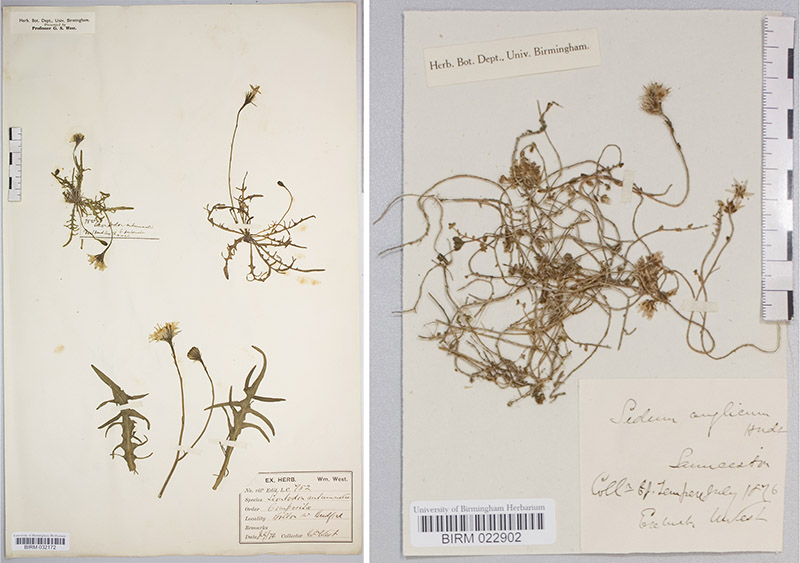
Figure 5.
Botanical specimens, collected by William West in 1878 (left), or collected by Jean Tempère in 1876 and later acquired by West (right). Adapted for nonprofit, educational purposes from http://herbariaunited.org/specimen/302287 and http://herbariaunited.org/specimen/280719.
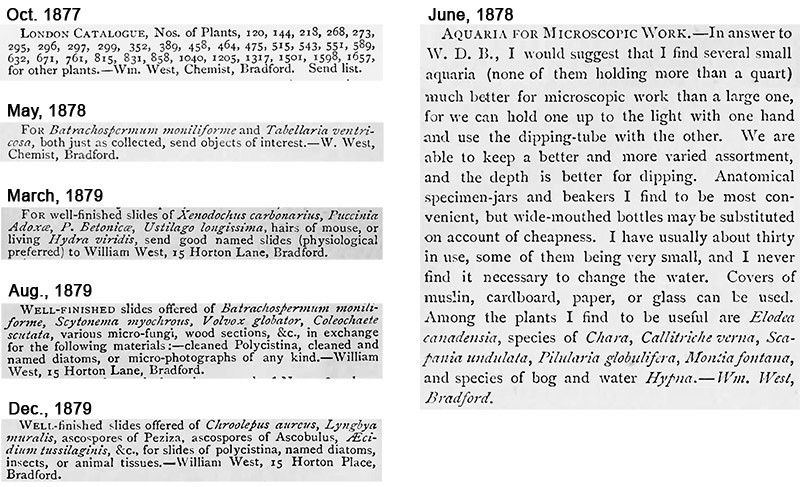
Figure 6.
Some early entries by William West that were published in “Hardwicke’s Science-Gossip”. West’s first known record is the October, 1877, exchange request for botanical specimens, which were identified by their index numbers from “The London Catalogue of British Plants”. His first offer to exchange his own prepared microscope slides appeared in March, 1879. He prepared a wide variety of specimen types. An 1878 letter to the magazine demonstrates that he was actively investigating with a microscope by June, 1878.
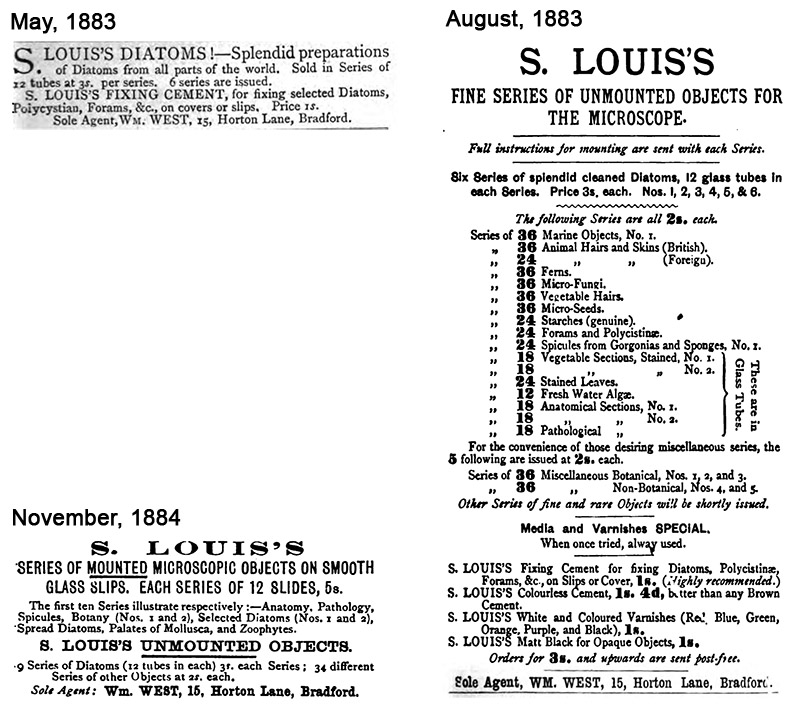
Figure 7.
Initial advertisements from “S. Louis”, the partnership between West and Jean Tempère. They first advertised in May, 1883, offering unmounted specimens. In November, 1884, they introduced mounted microscope slides.
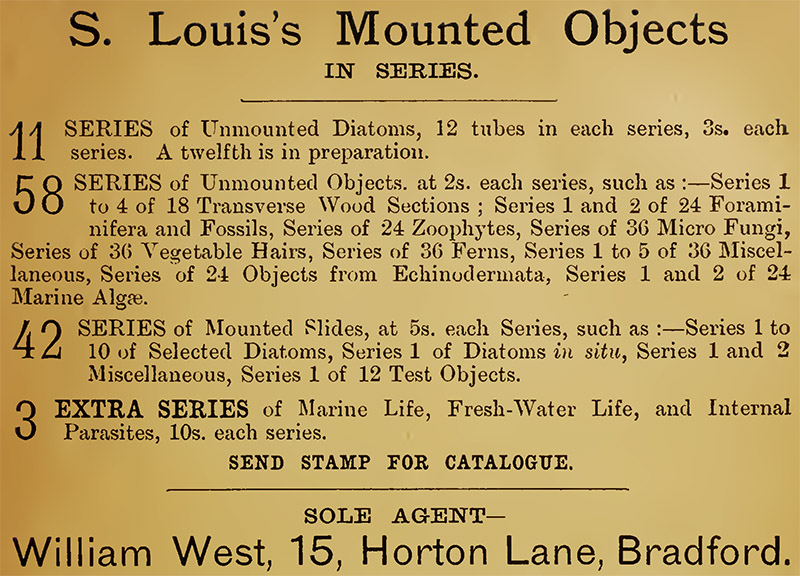
Figure 8.
An 1887 advertisement from “The Journal of Microscopy and Natural Science”, illustrating the depth and diversity of objects offered by West and Tempère.

Figure 9.
An 1888 exchange offer from West, which appeared in “Hardwicke’s Science-Gossip”. Note that he used S. Louis’ initials, probably as an indication that the person who provided the requested Volvox specimens would receive some free S. Louis slides.
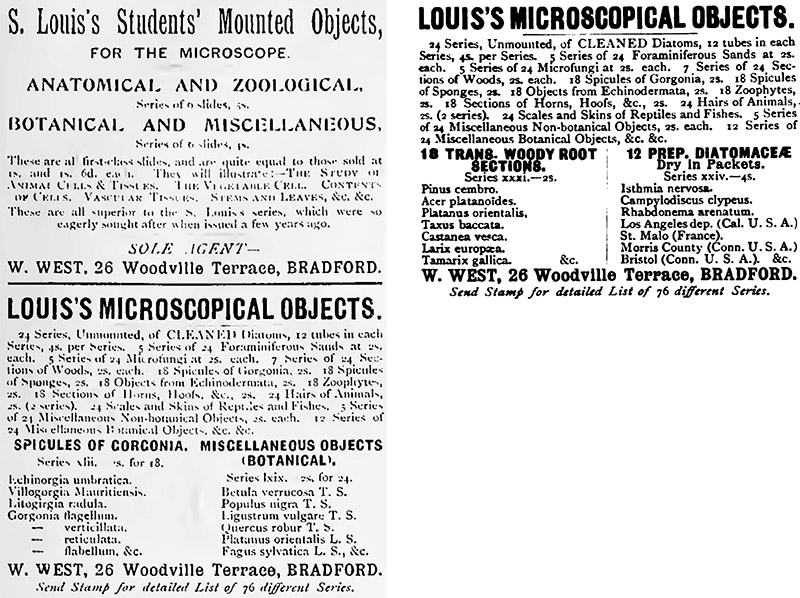
Figure 10.
Advertisements from 1900 (left) and 1901 (right), indicating that William West was still distributing “S. Louis” slides and unmounted material at the turn of the twentieth century.
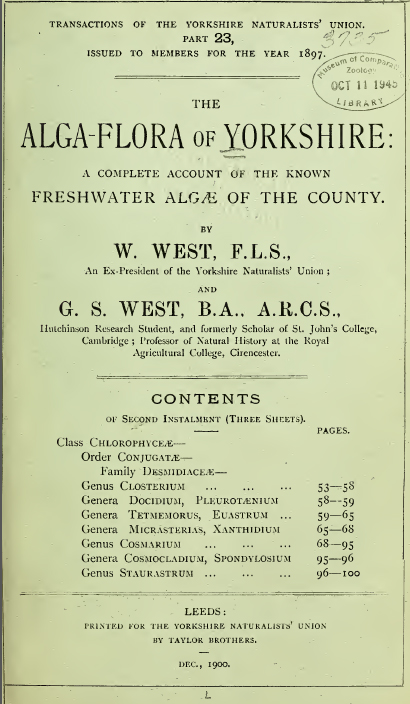
Figure 11.
Title page from the Wests’ “Alga-Flora of Yorkshire”.
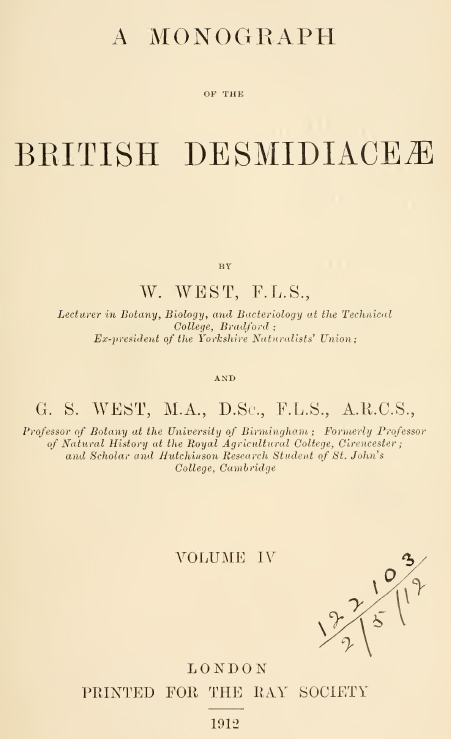
Figure 12.
Title page from the Wests’ “Monograph of the British Desmidiaceae”.
Acknowledgements
Thank you to Richard Courtiour and Peter Hodds for sharing images of slides from their collections.
Resources
Botanical Society and Exchange Club of the British Isles Report (1919) Obituary of George Stephen West, pages 630-635
Bracegirdle, Brian (1998) Microscopical Mounts and Mounters, Quekett Microscopical Club, London, pages 91-92, 101, and 182, plate 39-H
England census and other records, accessed through ancestry.com
Hardwicke’s Science Gossip (1877) Exchange offer from W. West, Vol. 13, page 240
Hardwicke’s Science Gossip (1878) Exchange offers from W. West, Vol. 14, pages 120, 144, and 192
Hardwicke’s Science Gossip (1879) Exchange offers from W. West and J. Tempère, Vol. 15, pages 96, 192, 264, and 284
Hardwicke’s Science Gossip (1883) Advertisement from S. Louis, Vol. 19, May issue advertiser sections
Hardwicke’s Science Gossip (1884) Advertisements for S. Louis preparations, Vol. 20, Numerous issues’ advertiser sections
Hardwicke’s Science Gossip (1877) Exchange offer from “S.L.”, Vol. 24, page 216
herbaria@home (accessed December, 2017) http://herbariaunited.org
The Journal of Microscopy and Natural Science (1884) Vol. 3, pages 66 and 196
The Journal of Microscopy and Natural Science (1887) Advertisement from S. Louis, Vol. 6
The Journal of the Linnean Society (1890) Members: “1887 Mar 17, West, William, Esq., 15 Horton-lane, Bradford, Yorkshire”, Vol. 25, page 36
Meiosis.org (accessed December, 2017) http://www.meiosis.org.uk/botanists/west-william-1848-1914/
The Naturalist (1891) “Members of the Linnean Society … 1887 Mar 17, West, William, Esq., Lect Bot & Mat Med Technical College; and 15 Horton-lane, Bradford, Yorkshire”, page 37
Nature (1914) Obituary of William West, pages 327-328
Probate of the will of William West (1914) “West William of 26 Woodville-terrace Horton Bradford died 15 May 1914 Administration London 3 June to George Stephen West professor of botany. Effects £2122 10s 8d”, accessed through ancestry.com
Proceedings of the British Pharmaceutical Conference (1873)
The Registers of Pharmaceutical Chemists and Chemists and Druggists (1885) page 265
Science Gossip (1900) Advertisements for S. Louis preparations, new series, Vol. 6
Science Gossip (1901) Advertisements for S. Louis preparations, new series, Vol. 7
West, William (1878) Anomalous parts of plants, Hardwicke’s Science Gossip, Vol. 14, page 19
West, William (1878) Solanum dulcamara, Hardwicke’s Science Gossip, Vol. 14, page 40
West, William (1878) White harebell, Hardwicke’s Science Gossip, Vol. 14, page 94
West, William (1878) Aquaria for microscopes, Hardwicke’s Science Gossip, Vol. 14, page 136
West, William, and George S. West (1896) On some new and interesting freshwater algae, Journal of the Royal Microscopical Society, pages 149-165
West, William, and George S. West (1900) The Alga-Flora of Yorkshire: A Complete Account of the Known Freshwater Algae of the County, Yorkshire Naturalists’ Union
West, William, and George S. West (1912) A Monograph of the British Desmidiaceae, Ray Society, London